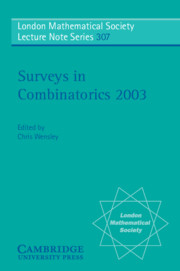Book contents
- Frontmatter
- Contents
- Preface
- W.T. Tutte, 1917–2002
- 1 Decompositions of complete graphs: embedding partial edge-colourings and the method of amalgamations
- 2 Combinatorial schemes for protecting digital content
- 3 Matroids and Coxeter groups
- 4 Defining sets in combinatorics: a survey
- 5 Finite projective planes with a large abelian group
- 6 Algorithmic aspects of graph homomorphisms
- 7 Counting lattice triangulations
- 8 Partition regular equations
- 9 Kostka–Foulkes polynomials and Macdonald spherical functions
3 - Matroids and Coxeter groups
Published online by Cambridge University Press: 05 May 2013
- Frontmatter
- Contents
- Preface
- W.T. Tutte, 1917–2002
- 1 Decompositions of complete graphs: embedding partial edge-colourings and the method of amalgamations
- 2 Combinatorial schemes for protecting digital content
- 3 Matroids and Coxeter groups
- 4 Defining sets in combinatorics: a survey
- 5 Finite projective planes with a large abelian group
- 6 Algorithmic aspects of graph homomorphisms
- 7 Counting lattice triangulations
- 8 Partition regular equations
- 9 Kostka–Foulkes polynomials and Macdonald spherical functions
Summary
Abstract
The paper describes a few ways in which the concept of a Coxeter group (in its most ubiquitous manifestation, the symmetric group) emerges in the theory of ordinary matroids:
Gale's maximality principle which leads to the Bruhat order on the symmetric group;
Jordan–Hölder permutation which measures distance between two maximal chains in a semimodular lattice and which happens to be closely related to Tits' axioms for buildings;
matroid polytopes and associated reflection groups;
Gaussian elimination procedure, BN-pairs and their Weyl groups.
These observations suggest a very natural generalisation of matroids; the new objects are called Coxeter matroids and are related to other Coxeter groups in the same way as (classical) matroids are related to the symmetric group.
Introduction
Combinatorics studies structures on a finite set; many of the most interesting of these arise from elimination of continuous parameters in problems from other mathematical disciplines.
Matroid is a combinatorial concept which arises from the elimination of continuous parameters from one of the most fundamental notions of mathematics: that of linear dependence of vectors.
Indeed, let E be a finite set of vectors in a vector space ℝn. Vectors α1,…, αk are linearly dependent if there exist real numbers c1,…, ck, not all of zero, such that c1α1+…+ckαk = 0. In this context, the coefficients c1,…,ck are continuous parameters; what properties of the set E remain after we decide never to mention them?
- Type
- Chapter
- Information
- Surveys in Combinatorics 2003 , pp. 79 - 114Publisher: Cambridge University PressPrint publication year: 2003
- 1
- Cited by

